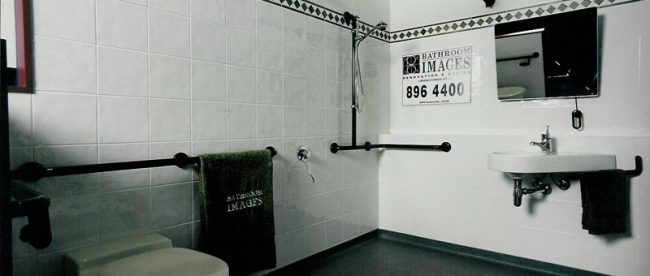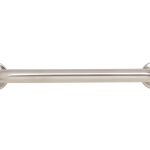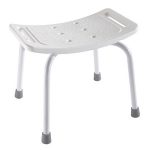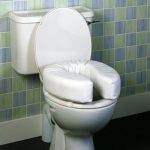Top 5 Ways to Outfit the Bathroom for Disabled or Elderly Loved Ones
Bathrooms can be very dangerous, both to the disabled and the elderly. The smooth surfaces, awkward movements, and generally solitary usage of the bathroom makes it one of the most common areas for accidental falls and injuries to occur, both for the elderly and the disabled.
However, given the prevalence of falls and injuries in bathrooms, there are many useful products on the market that can help prevent falls, and allow greater autonomy.
Let’s take a look at 5 of the best ways to outfit bathrooms to help your loved ones avoid falls and other dangerous situations, and give you greater peace of mind.
Grab Bars
Grab bars are perhaps the single most important addition you can make to a bathroom to help your loved ones avoid falls and injuries.
These simple devices are generally made out of a durable plastic or a high-quality stainless steel, and can be applied to walls in the shower, bath, or next to toilets to allow for increased grip and stability during awkward movements, such as getting on or off the toilet, stepping over a shower landing or a tub, or getting feet situated on a more slippery surface.
Grab bars are especially important for the disabled, as those who have trouble walking or are confined to wheelchairs will be unable to otherwise pull themselves onto the toilet.
They’re inexpensive, easy-to-install, and highly recommended as a preventative measure for falls.
Anti-Slip Mats
Anti-slip mats are incredibly important – but not just any mat will do. In fact, improperly secured mats and rugs are another leading cause of falls and injury among the elderly – a poor quality mat, or one that’s installed incorrectly, can actually increase the risk of injury in the bathroom.
The best anti-slip mats are made of a solid, durable rubber which offers great traction, and are usually quite thick – the thickness of these mats prevents the corners and edges from turning or flipping up, and reducing the hazard of tripping.
Anti-slip mats should be placed wherever slipping is likely to occur – not just in the shower, but also on smooth tile surfaces that are likely to become wet, or in front of the toilet if stability is a concern.
Shower Stools
The shower is one of the most dangerous areas in the bathroom. Most often, the cause of a fall in an elderly or disabled person in the shower can be traced to slipping – covered with an anti-slip mat – or fatigue.
The hot temperatures of the shower, combined with an inability to change the temperature or move easily out of the way of the water can cause an elderly person to lose energy and fall.
The best way to combat this is with a shower stool – these high-strength, high-traction, durable products are built to stand up to the shower, and allow your loved one the option of sitting down if they feel that standing is too tiring or risky.
Disabled people generally need shower stools for other reasons – if they cannot stand, a stool makes for a much more comfortable experience than sitting on the floor of the shower or the tub, and even those who can walk may wish to have the option to sit in case they feel tired.
Raised Toilet Seats
Though the shower is often thought of as the main culprit behind accidental falls, the toilet is just as likely to cause serious injury to an elderly person, and disabled people often have trouble adjusting to the awkward movement necessary to sit on a standard-sized and shaped toilet seat.
The best way to help prevent toilet falls is by making the toilet easier to access, and a great way to do this is with a raised toilet seat. These seats usually offer a 5-8 inch rise in height, along with other features like lockable latches and extra side handlebars to aid sitting and standing.
Make Sure That Bathrooms – And Hallways – Are Well Lit At Night
The elderly tend to visit the bathroom more than younger people – and quite a bit more at night. This can be dangerous – especially if there is a long connecting hallway between the bedroom and the bathroom. Often, there are unexpected objects and obstacles in hallways, and if these areas aren’t well-lit at night, your loved one could stumble and fall.
The hallways leading to bathrooms should be lit with as many night lights as necessary to illuminate the path to the bathroom, and ensure that any unexpected object can be seen and reacted to. Motion-sensing lights can be purchased if you’re worried about wasting energy.
The bathroom should also be well lit at night – a night light or motion-activated light is a good idea, as it will allow your loved one to easily locate light switches and other necessities with ease.
Make a Big Difference with Small Tweaks
While the bathroom still can be a risky area for the disabled and the elderly, the above five solutions are inexpensive, easy to implement, and can have a huge effect on your loved one.
Allowing your loved one to be able to use the bathroom with greater autonomy and peace of mind will also help you and the rest of your caregivers relax, knowing that you’ve protected your loved one from the risks of bathroom falls to the best of your ability, and that they have all the tools they need to stay safe.
Image Gallery:
- Grab bars in bathroom (image source: sea chrome.com)
- Anti slip mat (image source: specialistmats.co.uk)
- Shower stool (image source: showercaddyhq.net)
- Raised toilet seat (image source: clearwellmobility.co.uk)
Featured Image Source: Donutrockcity.com
This post was written by the www.vivehealth.com team.






These are some great tips – and they’re all really achievable. It’s really great these days to see how many options are actually available to those who have disabilities when it comes to bathrooms and independence. One of the things my husband was actually most alarmed about when his health started to initially deteriorate, was the bathroom and his own independence. He didn’t want to have to rely on others too much, and still wanted to be able to bathe himself and such. I was originally sceptical of how achievable this was and thought we’d have to go against his wishes and install a load of hoists and things to help him get in and out of the bath and shower. But nowadays with all that’s available – this is certainly not the case! There are so many wonderful options these days, from showers with seats, to slide in baths – it really is absolutely amazing! I believe the home my husband is currently in has an accessible bath from Gainsborough (I’m 98% sure that’s the company anyway) – and he loves it because he has his all important independence! Equipment like this really does make all the difference, and it’s fantastic to see so many wonderful options out there nowadays, and it’s so great to read articles like this that show people that.
http://www.myshowerchair.com
Necessity is the mother of invention; I really think this new product on the market will help you. It is a hands free shower chair. Take a look at the video; it could be just what you are looking for!
Regards,
Julie
Helping out my grandparents in finding a good walk-in bath, and just want to know which is the best sort for elderly people? There are a view different types from a company local to them called Gainsborough, any comments would be a great help! http://www.gainsboroughbaths.com/product/walk-in-baths
A inexpensive way for a disabled person to bathe is using the new hands free shower chair and it fits in a standard shower. It has soap and rinse cycle(s) plus a hand held wand to wash the upper body. I highly recommend this for someone who doesn’t want to remodel and have a bathing experience without assistance. http://www.myshowerchair.com